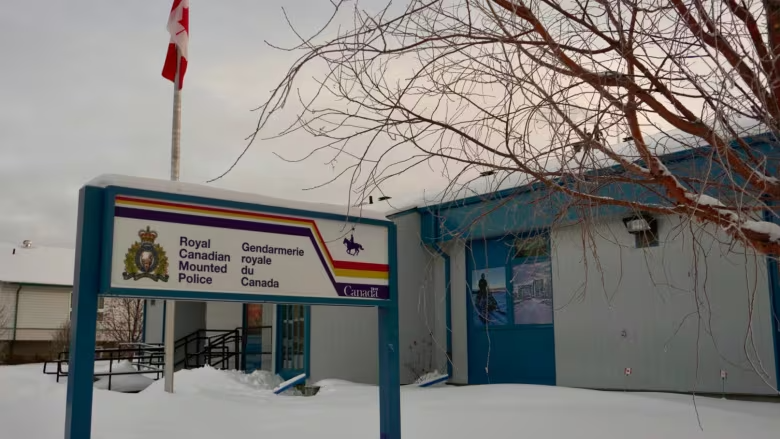Canada News
At least two organized crime groups operating in N.W.T., RCMP say

Sign outside building reads, “Royal Canadian Mounted Police”. The RCMP detachment in Hay River, N.W.T. (Natalie Pressman/CBC)
By RCI, CBC News
Police believe shootings in Hay River part of ‘conflict’ between the groups
In the wake of two shootings in Hay River this month, the N.W.T. RCMP say at least two organized crime groups are operating in the territory.
Those shootings — as well as shootings in April and January in the territory — are all believed to be related to the drug trade.
Const. Josh Seaward, a media relations officer with the Yellowknife RCMP, spoke with CBC Trailbreaker guest host Shannon Scott Monday about the situation and who might be behind these recent incidents.
This conversation has been edited for clarity and length.
Do you have a sense of why we’re seeing events like this in Hay River?
Unfortunately, in the rest of Canada as well as the Northwest Territories, drug use is becoming a big issue. There’s a large trade in crack cocaine. There’s at least two organized crime groups that are operating here at the moment. There’s a larger user base, so these issues are likely related to that.
So is this, for lack of a better term, a turf war that we’re seeing?
I wouldn’t label it a turf war necessarily. But it would be fair to say there is some conflict.
What do you know about these organizations? Where they’re based, what brings them to the North?
Well, these organizations are generally coming from the south. There are ties to Alberta. We’ve also seen some ties to Ontario. The Northwest Territories is a market where drugs can go for a premium. You know, we’re isolated up here and there’s not a lot of presence with these groups. so whoever comes here has a large market that’s easy to corner, I guess.
What threat do they pose to the community?
It’s the same threat that they would pose anywhere else. The social impact and the health impacts of drug use in general are the largest. Incidents like these, these shootings are generally very targeted in nature. It’s not as though they drive around shooting up the houses of the general public. The conflict is isolated to players within those groups.
So with all of that in mind, what specific actions are associated with these gangs?
Of late, the RCMP in the Northwest Territories have deployed a drug strategy that increased training for officers on the ground. We’ve improved our ability to collect and disseminate intelligence in relating to these things. We’ve increased our capacity to disrupt the drug trade. You may have noticed as well in the media we’re going to be more public, more transparent with who these players are when we’re charging them and trying to keep people more informed as this is somewhat of a community effort more than a policing effort. Public safety is everyone’s responsibility. The police are just the instrument.
Further to that, we have received funding for and have created a new territorial crime reduction unit, which has a primary mandate of … proactive investigations that have the greatest impact on public safety here, generally focusing on the trafficking of drugs and people and firearms and violent prolific offenders.
Do you have enough RCMP officers and resources in the community to manage this situation effectively?
We’re very pleased to have this territorial unit with us to bolster our capacity. As of right now, the officers that we do have on the ground are more than capable of responding to these matters. It’s just we want to improve our capacity further to provide the best service possible.
These two organized crime groups that seem to operating in Hay River, do you have a sense of how long it’s been in the North, how well-established they are?
It’s difficult to say exactly because things have been really ramping up just as of late and kind of coming more to the forefront. Years ago, especially with the stigma around drug use, things were certainly more on the down low … as more information becomes available and more intelligence is disseminated, we are getting a better picture of it.
Is there a long-term strategy to dismantle these networks in the North?
Like I said earlier about the drug strategy for disruption, and the creation of this new team — we’re working toward a strategy to sort of dismantle and address these things, but again, it’s a dynamic situation and the more we know, the more we’re able to tailor our response.
This increase in violence in the community has prompted some residents so start patrolling the streets themselves … They’re also posting pictures of specific homes in the community. What is your take on citizens playing that kind of role?
The sharing of information with police is one of the best ways the public can contribute to reducing the overall prevalence of drugs and organized crime. What we don’t want is for anybody to put themselves in a position where they could be subject to violence or retaliation.
Posting things to social media is not nearly as effective as coming to a police officer with the information you have.
What message would you have for people who are maybe feeling scared or disillusioned by the current level of crime in the community?
If we can pull together as a community and family units to just have more social supports in place for people to prevent this from happening in the first place, decrease the stigma, you’re way more likely to have success on this front and reduce the overall harm that everyone is experiencing from this.
Written by Emma Tranter with files from Shannon Scott





















